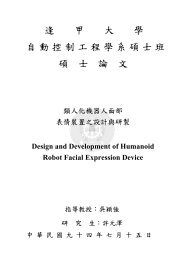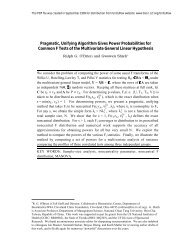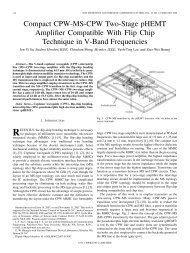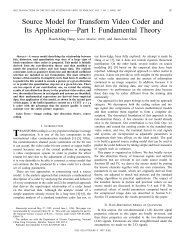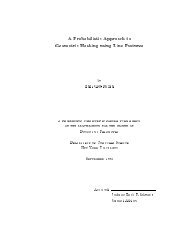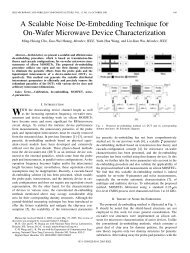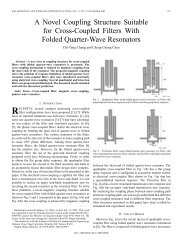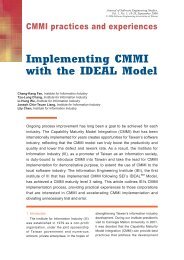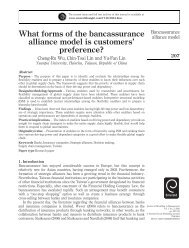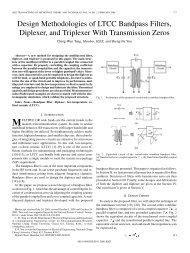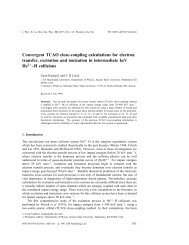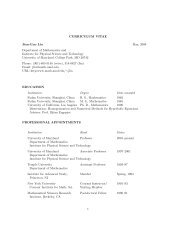doped SiO2 by yttrium codoping
doped SiO2 by yttrium codoping
doped SiO2 by yttrium codoping
You also want an ePaper? Increase the reach of your titles
YUMPU automatically turns print PDFs into web optimized ePapers that Google loves.
Fluorescence enhancement and structural development of sol–gel<br />
derived Er 31 -<strong>doped</strong> SiO 2 <strong>by</strong> <strong>yttrium</strong> <strong>codoping</strong><br />
San-Yuan Chen,* Chu-Chi Ting and Chia-Hou Li<br />
Department of Materials Science and Engineering National Chiao-Tung University, 1001<br />
Ta-hsueh Road, Hsinchu 300 Taiwan, Republic of China. E-mail: sychen@cc.nctu.edu.tw;<br />
Fax: 886-3-5725490; Tel: 886-3-5731818<br />
Received 13th August 2001, Accepted 22nd January 2002<br />
First published as an Advance Article on the web 4th March 2002<br />
Er 31 –Y 31 co<strong>doped</strong> SiO 2 powdered bulks were prepared <strong>by</strong> a sol–gel process. The effect of Y 31 <strong>codoping</strong> on<br />
the fluorescence properties and structural development of Er 31 -<strong>doped</strong> SiO 2 is investigated. The maximum<br />
y1.54 mm photoluminescence (PL) intensity occurs in the sample with Er 31 (10 mol%)–Y 31 (50 mol%)<br />
co<strong>doped</strong> and annealed at 985 uC. This can be attributed to the competition between the content of hydroxy<br />
groups and Er site symmetry. Improvement of optimum PL properties due to Y 31 <strong>codoping</strong> <strong>by</strong> a factor of<br />
y20 for intensity and 1.8 for the full width at half maximum (57 nm) was obtained in comparison with the<br />
Er 31 -<strong>doped</strong> SiO 2 system. Extended X-ray absorption fine structure analysis shows that the local chemical<br />
environment of Er 31 ions in the Er 31 –Y 31 co<strong>doped</strong> SiO 2 is similar to that in Er 2 O 3 . The average spatial<br />
distance between Er 31 ions is enlarged due to a partial substitution of Y 31 for Er 31 ions in the Er 2 O 3 -like local<br />
structure, which results in a reduction of the concentration quenching effect.<br />
1. Introduction<br />
Rare-earth <strong>doped</strong> materials play very important roles in<br />
optoelectronics technology because they have good performance<br />
in the application of lasers and optical amplifiers. 1–3<br />
Among these rare-earth elements, the y1.54 mm photoluminescence<br />
(PL) properties of Er 31 ions are of particular interest<br />
in fiber optical communication systems because it matches the<br />
lowest signal attenuation in silica-based optical fibers. 4,5<br />
The y1.54 mm PL efficiency was strongly influenced <strong>by</strong> some<br />
factors such as the local symmetry of Er 31 sites in the host<br />
matrix, the concentration quenching effect, and the content of<br />
hydroxy impurities (OH 2 ) in the sol–gel derived materials. 6,7 In<br />
the case of free Er 31 ions, the y1.54 mm optical emission of<br />
internal 4f–4f transitions (between the 4 I 13/2 first excited and the<br />
4 I 15/2 ground state) is electric dipole forbidden. If the symmetry<br />
of the local crystal field around the Er 31 lattice sites in the host<br />
matrix is distorted, the parity forbidden intra-4f transition will<br />
be allowed. 8,9 Additionally, for a high Er 31 doping, the Er 31<br />
ions tend to form clusters and the mean interaction distance<br />
between Er 31 ions becomes small, which results in substantial<br />
losses of excitation energy through the ion–ion interaction<br />
mechanism (e.g., co-operative up-conversion cross-relaxation<br />
and resonant energy migration) between the two near<strong>by</strong> Er 31<br />
ions. In other words, the chemical environment of Er 31 ions<br />
(i.e. the site symmetry and clustering of Er 31 ions) in the host<br />
matrix significantly affects the luminescence efficiency. Therefore,<br />
the addition of specific heteroatoms into the host matrix<br />
to reduce the site symmetry and clustering of Er 31 ions will be<br />
the most efficient method to promote the y1.54 mm PL<br />
intensity. For instance, it is well known that the solubility of<br />
Er 31 ions in silicate hosts is very low. Many researchers have<br />
tried to codope Al 31 or P 31 ions with Er 31 ions into a silicate<br />
host in order to provide enough non-network oxygen species<br />
and hence decrease the concentration quenching effect. 10–13<br />
The addition of co-dopants Al 31 or P 31 ions has focused on the<br />
modification of the host matrix to improve the Er solubility.<br />
However, the structural role of Er in the host matrix has been<br />
neglected.<br />
Y 31 /Er 31 ions have similar ionic radii (Y 31 ~ 0.0892, and<br />
Er 31 ~ 0.0881 nm) and Y 2 O 3 /Er 2 O 3 have nearly the same<br />
crystal structure and lattice constant. Therefore, we have tried<br />
to codope Y 31 ions into the Er 31 -<strong>doped</strong> SiO 2 network <strong>by</strong> the<br />
sol–gel method in the present work. The role of the Y 31<br />
codopant in the phase development and PL properties of Er 31 -<br />
<strong>doped</strong> silica materials will be investigated. Additionally, the<br />
extended X-ray absorption fine structure (EXAFS) technique<br />
will be used to analyze the influence of Y 31 ions on the local<br />
chemical environment around the Er 31 ions in an Er 31 –Y 31<br />
co<strong>doped</strong> SiO 2 system.<br />
2. Experimental<br />
2.1. Sample preparation<br />
TEOS [tetraethoxysilane, Si(OC 2 H 5 ) 4 , Merck, 99.5%] was used<br />
as the silicon alkoxide precursor for all of the Er 31 -<strong>doped</strong><br />
samples. Erbium nitrate pentahydrate [Er(NO 3 ) 3 ?5H 2 O, Alfa,<br />
99%], and <strong>yttrium</strong> nitrate pentahydrate [Y(NO 3 ) 3 ?5H 2 O, Alfa,<br />
99%] were used as the sources of Er 31 and Y 31 ions,<br />
respectively. TEOS was first added to the mixture solution of<br />
deionized water and ethanol (Merck, 99.9%) (the molar ratio of<br />
TEOS : H 2 O:C 2 H 5 OH ~ 1 : 5 : 10), followed <strong>by</strong> stirring for<br />
30 min. Then the erbium solution (erbium nitrate : H 2 O ~<br />
1 : 10) and <strong>yttrium</strong> solution (<strong>yttrium</strong> nitrate : H 2 O ~ 1 : 10)<br />
were spontaneously dropped into the initial TEOS solution.<br />
This sol solution was vigorously stirred at room temperature<br />
for 10 h in order to ensure a sufficient degree of hydrolysis and<br />
polycondensation. Molar ratios of Er 31 and Y 31 (relative to<br />
Si 41 ) ranging from 0.5 to 10% and 10 to 50% were used,<br />
respectively.<br />
The final sol solutions were aged at room temperature for 6<br />
days and gelled at 50 uC in about 2 weeks. Gels were heattreated<br />
at 100 uC in air for 6 days and were then pyrolyzed at<br />
700 uC for 1 h in a dry oxygen atmosphere at a heating rate of<br />
2 uC h 21 to remove organic species. Pyrolyzed gel powder was<br />
die-pressed to be a 1 cm-diameter pellet and then annealed at<br />
800–1400 uC for 1 h in a dry oxygen atmosphere at a heating<br />
rate of 10 uC min 21 .<br />
1118 J. Mater. Chem., 2002, 12, 1118–1123 DOI: 10.1039/b107380j<br />
This journal is # The Royal Society of Chemistry 2002
2.2. Characterization measurements<br />
The phase structure of the samples was determined <strong>by</strong> an X-ray<br />
diffractometer (MAC Science, M18X) using Cu-Ka radiation.<br />
Fourier transform infrared (FTIR) spectra were recorded on a<br />
Perkin–Elmer 580 spectrometer. A transmission electron<br />
microscope (TEM, JEOL-2000FX) equipped with EDX was<br />
used to observe and analyze the microstructure. The fluorescence<br />
spectra were excited <strong>by</strong> a 980 nm laser diode with a power<br />
of 50 mW inclined 45u to irradiate the samples and recorded<br />
normally from the samples using a spectrophotometer<br />
equipped with a liquid N 2 -cooled Ge detector (NCSC).<br />
Erbium L III -edge X-ray absorption spectra were recorded on<br />
Wiggler beamline S-05B at the Synchrotron Radiation<br />
Research Center (SRRC), Hsinchu, Taiwan. The electron<br />
storage ring was operated at an energy of 1.3 GeV and a<br />
current of 80–200 mA. A Si (111) double-crystal monochromator<br />
with a 0.5 mm entrance slit was used for energy<br />
scanning. The energy resolution, DE/E, was about 1.9 6 10 24 .<br />
Measurements were performed at room temperature in<br />
fluorescence mode and the sample was positioned at 45u to<br />
the incident X-ray beam. A polycrystalline Er 2 O 3 powder<br />
(Cerac, 99.9%) was used as a reference standard.<br />
3. Results<br />
The X-ray diffraction (XRD) patterns in Fig. 1 illustrate the<br />
effect of the annealing temperatures on the structural evolution<br />
of pure SiO 2 ,Er 31 -<strong>doped</strong> SiO 2 and Y 31 -<strong>doped</strong> SiO 2 , where the<br />
silicate host co<strong>doped</strong> with Er 31 (20 mol%)–Y 31 (0 mol%) and<br />
annealed at 1100 uC is denoted as ‘‘Er20 Y0 1200 uC’’. For<br />
annealing temperatures below 1300 uC, the pure SiO 2 host<br />
exhibits an amorphous structure. The polymorphic SiO 2 is<br />
detectable when the annealing temperature exceeds 1400<br />
uC. When 10 mol% Er 31 ions were added into the SiO 2<br />
matrix, it was found that phase crystallization occurs at 1100<br />
uC. With increasing Er 31 concentration up to 20 mol%, the<br />
well-defined crystalline phase can be clearly identified as the Erpyrosilicate<br />
phase (Er 2 Si 2 O 7 ). 14 On the other hand, Y 31 -<strong>doped</strong><br />
SiO 2 exhibits similar crystallization behavior to Er 31 -<strong>doped</strong><br />
SiO 2 and also forms the polymorphic Y-pyrosilicate phase<br />
(Y 2 Si 2 O 7 ) at 1100 uC. 15 Notedly, both Er 2 Si 2 O 7 and Y 2 Si 2 O 7<br />
phases have almost the same XRD patterns, which means that<br />
both Er- and Y-pyrosilicates have the same crystal structure<br />
and nearly the same lattice constant.<br />
The effect of <strong>yttrium</strong> concentration on the phase evolution of<br />
the Er 31 (5 mol%)-<strong>doped</strong> SiO 2 at different annealing temperatures<br />
is shown in Fig. 2. When annealed at 985 uC/1 h,<br />
even though as high as 50 mol% Y 31 was added into the<br />
Er 31 -<strong>doped</strong> SiO 2 , the XRD pattern shows an amorphous<br />
Fig. 2 X-Ray diffraction patterns of Er 31 (5 mol%)–Y 31 co<strong>doped</strong> SiO 2<br />
samples (a) annealed at temperatures of 900–1000 uC/1 h, and (b) with<br />
different Y 31 concentration and annealed at 985 uC/1 h.<br />
structure. The relationship between the total Er 31 1 Y 31<br />
<strong>codoping</strong> concentration and annealing temperatures for the<br />
crystallization behavior of Er 31 –Y 31 co<strong>doped</strong> SiO 2 samples is<br />
further summarized in Fig. 3. For example, when the total<br />
concentration of Er 31 and Y 31 ions is more than 30 mol%, the<br />
crystalline phase (Er x Y 22x Si 2 O 7 ) will be generated for all of the<br />
samples annealed at 985 uC.<br />
Fig. 4 shows the FTIR spectra of the Er 31 –Y 31 co<strong>doped</strong><br />
SiO 2 samples annealed at 800 and 1000 uC for 1 h. The FTIR<br />
spectrum of Er 31 (5 mol%)–Y 31 (10 mol%) co<strong>doped</strong> SiO 2<br />
annealed at 800 uC is found to be similar to that of the pure<br />
silicate. The bands around 1079 cm 21 and 796 cm 21<br />
correspond to the Si–O–Si antisymmetrical and symmetrical<br />
stretching vibrations, respectively. 16,17,18 The band around 455<br />
cm 21 is due to the Si–O–Si and O–Si–O bending modes. 18–20<br />
However, with increasing Y 31 concentration (from 30 to<br />
Fig. 1 X-Ray diffraction patterns of SiO 2 and Er 31 (or Y 31 )-<strong>doped</strong><br />
SiO 2 samples annealed at different temperatures for 1 h.<br />
Fig. 3 Dependence of crystallization behavior of Er 31 –Y 31 co<strong>doped</strong><br />
SiO 2 samples on total Er 31 1 Y 31 <strong>codoping</strong> concentration and<br />
annealing temperatures.<br />
J. Mater. Chem., 2002, 12, 1118–1123 1119
Fig. 4 FTIR absorption spectra of Er 31 –Y 31 co<strong>doped</strong> SiO 2 samples<br />
annealed at different temperatures for 1 h.<br />
50 mol%), the band around 1079 cm 21 becomes broad and the<br />
band around 796 cm 21 gradually weakens and disappears. This<br />
reveals that the network structure of short-range order<br />
tetrahedral SiO 4 was destroyed and became more disordered.<br />
In addition, all of the samples exhibit a broad absorption in the<br />
3000–3450 cm 21 region (the O–H stretching vibration) and a<br />
small band at y1620 cm 21 (the molecular H–O–H bending<br />
mode). 18,21,22 This indicates that there exists a variety of<br />
hydroxy groups such as isolated Si–OH groups, pairs of<br />
hydrogen bonded Si–OH and physically adsorbed water<br />
molecules in the silica matrix. 18,21,22<br />
As the sample was annealed at 1000 uC, some newly-formed<br />
peaks at 585, 851, 966 and 1084 cm 21 in the FTIR spectra were<br />
observed for the samples with a Y 31 concentration above<br />
30 mol% that could be related to the formation of the<br />
crystalline pyrosilicate Er x Y 22x Si 2 O 7 phase. However, the<br />
assignment of these peaks is not the focus of this paper.<br />
Additionally, the absorption bands around 3000–3450 and<br />
1620 cm 21 have obviously disappeared. Since the content of<br />
hydroxy quenching centers is sensitive to the annealing temperature,<br />
the FTIR spectra in the range of 4000–3000 cm 21<br />
(where the intensity of absorption bands represents the content<br />
of hydroxy groups) were performed for the Er 31 (5 mol%)–<br />
Y 31 (50 mol%) co<strong>doped</strong> SiO 2 samples annealed at 800–<br />
1000 uC. Fig. 5 illustrates that the content of hydroxy groups is<br />
rapidly reduced with an increase of annealing temperature<br />
from 970 to 1000 uC.<br />
Fig. 6 illustrates the y1.54 mm PL spectra of the Er 31 (1 and<br />
5 mol%)–Y 31 (0–50 mol%) co<strong>doped</strong> SiO 2 samples annealed at<br />
985 uC for 1 h. These spectra exhibit a broad PL emission that<br />
consists of a y1.538 mm main peak and some broad shoulders.<br />
Moreover, the spectral bandwidths also become enlarged with<br />
Fig. 5 FTIR absorption spectra between 4000 and 3000 cm 21 showing<br />
the effect of annealing temperature on the hydroxy content of Er 31 (5<br />
mol%)–Y 31 (50 mol%) co<strong>doped</strong> SiO 2 samples.<br />
Fig. 6 y1.54 mm PL spectra of (a) Er 31 (1 mol%) and (b) Er 31 (5<br />
mol%)–<strong>doped</strong> SiO 2 samples with different Y 31 concentration co<strong>doped</strong><br />
and annealed at 950 uC for 1 h. All of the spectra are normalized on the<br />
same basis of intensity for comparison among spectral features.<br />
more Y 31 codopant being added. Fig. 7 shows the annealing<br />
temperature dependence of the y1.54 mm PL spectra observed<br />
from the Er 31 (5 mol%)–Y 31 (50 mol%) co<strong>doped</strong> SiO 2 samples.<br />
The broad PL spectra will split into many sharp lines when the<br />
crystalline Er x Y 22x Si 2 O 7 phase is generated in the host matrix<br />
at 1000 uC.<br />
The effect of annealing temperature on the PL intensity of<br />
the Er 31 (1–10 mol%)–Y 31 (50 mol%) co<strong>doped</strong> SiO 2 samples is<br />
further illustrated in Fig. 8. The results reveal that the PL<br />
intensities were enhanced with increasing annealing temperatures<br />
from 800 to 985 uC, while it decreased above 1000 uC. The<br />
dependence of Er 31 and Y 31 concentration on the PL<br />
intensity of Er 31 –Y 31 co<strong>doped</strong> SiO 2 samples annealed at 985 uC<br />
for 1 h is schematically summarized in Fig. 9. The PL<br />
intensity of the Er 31 (5 and 10 mol%)–Y 31 co<strong>doped</strong> SiO 2<br />
samples increases remarkably with the increase of the Y 31<br />
<strong>codoping</strong> level. However, for the Er 31 (1 mol%)–Y 31 co<strong>doped</strong><br />
SiO 2 samples, the PL intensities are slightly reduced when the<br />
Y 31 <strong>codoping</strong> level exceeds 30 mol%. Notably, the PL intensity<br />
of the Er 31 (5 and 10 mol%)-<strong>doped</strong> SiO 2 sample can be<br />
increased <strong>by</strong> a factor of almost 20 in the presence of 50 mol%<br />
Y 31 codopant, demonstrating that Y 31 <strong>codoping</strong> is a very<br />
efficient method for enhancing the PL intensity in the Er 31 -<br />
<strong>doped</strong> SiO 2 system.<br />
Fig. 10 shows the pseudo-radial distribution functions<br />
obtained from the k 3 -weighted Fourier transforms of the<br />
Er 31 –Y 31 co<strong>doped</strong> SiO 2 samples annealed at 900–1000 uC for<br />
1 h. Qualitative observation reveals that the first-neighbor<br />
1120 J. Mater. Chem., 2002, 12, 1118–1123
Fig. 10 Fourier transform partial radial distribution function for the<br />
Er 31 –Y 31 co<strong>doped</strong> SiO 2 samples annealed at 900–1100 uC for 1 h.<br />
Fig. 7 y1.54 mm PL spectra of Er 31 (5 mol%)–Y 31 (50 mol%) co<strong>doped</strong><br />
SiO 2 samples annealed at 900–1100 uC for 1 h. All of the spectra are<br />
normalized on the same basis of intensity for comparison among<br />
spectral features.<br />
neighbor in Er 2 O 3 . Therefore, the local chemical environment<br />
of Er 31 ions in the amorphous Er 31 –Y 31 co<strong>doped</strong> SiO 2<br />
samples is an Er 2 O 3 -like environment. At 1000 uC, the EXAFS<br />
curves of the Er 31 (5 mol%)–Y 31 (50 mol%) co<strong>doped</strong> SiO 2<br />
samples illustrate that the first shell is like that of Er 2 O 3 but its<br />
outer shells are obviously different from those of amorphous<br />
samples because the coordination number of the Er 31 ion in the<br />
well-crystalline Er x Y 22x Si 2 O 7 phase is still 6-fold. 23,24<br />
4. Discussion<br />
4.1. Influence of Y 31 content and annealing temperature on the<br />
PL properties<br />
Fig. 8 PL intensity of Er 31 –Y 31 (50 mol% ) co<strong>doped</strong> SiO 2 samples as<br />
functions of Er 31 content and annealing temperatures.<br />
distance of Er 31 at 900 uC is similar to that of the crystalline<br />
Er 2 O 3 , indicating that the first neighbors of Er 31 ions are<br />
primarily composed of O atoms. The second nearest neighbor<br />
distance of Er 31 is close to the distance of the second nearest<br />
Fig. 9 Dependence of Er 31 and Y 31 concentration on the PL intensity<br />
of Er 31 –Y 31 co<strong>doped</strong> SiO 2 samples annealed at 985 uC for 1 h.<br />
When the Er 31 (1–10 mol%)–Y 31 (0–50 mol%) co<strong>doped</strong> SiO 2<br />
samples were annealed at 950 uC, all of them have an<br />
amorphous structure and all exhibit similar broad PL spectra<br />
(see Fig. 6). However, there still existed an apparent difference<br />
in FWHM between these spectra. The FWHM is y45 nm for<br />
the Er 31 (1 mol%)–Y 31 (10 mol%) co<strong>doped</strong> SiO 2 , which is<br />
larger than that of the Er 31 (1 mol%)-<strong>doped</strong> SiO 2 without the<br />
Y 31 codopant (FWHM ~ y31 nm). The broadening of the PL<br />
spectra indicates that the Y 31 codopant plays a modifier role in<br />
affecting the bonding environment of Er 31 ions that can lead to<br />
a wider diversity of Er 31 bonding sites. However, for Er 31<br />
(1 mol%)–Y 31 co<strong>doped</strong> SiO 2 samples with a Y 31 concentration<br />
varying form 10 to 50 mol%, the spectral bandwidth does not<br />
show an apparent difference. This implies that 10 mol% Y 31<br />
<strong>codoping</strong> is enough to modify the Er bonding environment and<br />
maximize the Er site diversity in the SiO 2 matrix. The abovementioned<br />
phenomenon is also observed for the Er 31 –Y 31<br />
co<strong>doped</strong> SiO 2 samples with a larger amount of Er 31 (5–<br />
10 mol%). The full width at half maximum (y57 nm) is also<br />
larger than that (y40 nm) of the Er 31 (5–10 mol%)-<strong>doped</strong> SiO 2<br />
without Y 31 <strong>codoping</strong>.<br />
The phase evolution of Er 31 –Y 31 co<strong>doped</strong> SiO 2 samples is<br />
strongly dependent on the Er 31 1 Y 31 concentration and<br />
annealing temperature. As shown in Fig. 3, for the samples<br />
with an Er 31 1 Y 31 concentration greater than 30 mol% and<br />
annealed above 985 uC, the highly crystalline Er x Y 22x Si 2 O 7<br />
phase forms in the host matrix. The TEM micrograph of an<br />
Er 31 (5 mol%)–Y 31 (50 mol%) co<strong>doped</strong> SiO 2 sample annealed<br />
at 1000 uC shows that many dark small droplet precipitates<br />
were observed (Fig. 11). 25–27 The energy-dispersive X-ray<br />
(EDX) analysis reveals that these precipitates contain Er and<br />
Y elements. As compared with XRD patterns (Fig. 2(a)), these<br />
precipitates should be the Er x Y 22x Si 2 O 7 phase. This indicates<br />
that most of the Er 31 ions are located on the well-defined sites<br />
of the Er x Y 22x Si 2 O 7 phase. Therefore, a number of sharp PL<br />
lines were observed as shown in Fig. 7.<br />
Since both the content of hydroxy groups (i.e., quenching<br />
J. Mater. Chem., 2002, 12, 1118–1123 1121
Fig. 11 TEM micrograph of Er 31 (5 mol%)–Y 31 (50 mol%) co<strong>doped</strong><br />
SiO 2 annealed at 1000 uC for 1 h.<br />
centers) and the symmetry of local structure around the Er 31<br />
ions can affect the PL intensity, the final-revealed PL intensity<br />
results from the competition between these two factors. For the<br />
samples annealed at 970 uC (i.e., no crystalline Er x Y 22x Si 2 O 7<br />
phase existing in the host matrix), the varying PL intensity is<br />
primarily related to the amount of OH 2 hydroxy impurities.<br />
Therefore, in the temperature range 800–970 uC, the PL<br />
enhancement with increasing annealing temperature is mostly<br />
attributed to the decrease of the hydroxy quantity. 28–31<br />
When the annealing temperature reached 985 uC, the poorly<br />
crystalline Er x Y 22x Si 2 O 7 phase had formed in the host matrix<br />
and resulted in the reduction of the probability of the 4 I 13/2 A<br />
4 I 15/2 transitions. However, a maximum PL intensity was<br />
observed at this temperature (985 uC) that reveals that the<br />
greatly decreased content of hydroxy quenching centers (see<br />
Fig. 5) can still offset the influence of the higher local symmetry<br />
of the Er site. On the other hand, as the samples were annealed<br />
at higher temperatures above 1000 uC, the Er x Y 22x Si 2 O 7 phase<br />
has been highly crystallized and thus the local structure around<br />
the Er 31 ions becomes more symmetric. Therefore, an abrupt<br />
reduction of the PL intensity is observed.<br />
4.2. Role of Y 31 codopant on the development of Er 31 local<br />
structure<br />
EXAFS analysis in Fig. 10 shows that there is local Er 2 O 3 -like<br />
structure in the amorphous Er 31 –Y 31 co<strong>doped</strong> SiO 2 host<br />
matrix. These Er sites with Er 2 O 3 -like local symmetry are<br />
generally thought of as the active luminescent centers. 32–34<br />
Because Er 31 and Y 31 have the same valence and similar ionic<br />
radii (0.0881 and 0.0892 nm, respectively), they could be<br />
replaced <strong>by</strong> each other. Therefore, <strong>by</strong> <strong>codoping</strong> Y 31 ions into<br />
the Er 31 -<strong>doped</strong> SiO 2 network, we believe that the –Er–O–Er–<br />
O–Er– bonding structure can be possibly changed into –Er–O–<br />
(Y–O) n –Er–, which indicates that the average interionic<br />
distance between Er 31 ions can be enlarged. Additionally,<br />
the FTIR spectra (see Fig. 4) shows that the addition of a large<br />
number of Y 31 codopant could destroy the network of SiO 2 ,<br />
leading to an increase of non-bridging oxygen groups in the<br />
SiO 2 matrix as observed in the Er 31 -<strong>doped</strong> SiO 2 system <strong>by</strong> Al 31<br />
<strong>codoping</strong>. 10–13 Some works reported that the non-bridging<br />
oxygen groups can reduce the tendency of the Er 31 ions to<br />
cluster. 10,13 According to the above-mentioned mechanism, the<br />
Y 31 codopant plays an important role in increasing the<br />
dispersion and solubility of Er 31 ions in the amorphous Er 31 –<br />
Y 31 co<strong>doped</strong> SiO 2 systems, which results in a reduction of the<br />
concentration quenching effect and an increase of PL intensity.<br />
These explanations are very consistent with our experimental<br />
results evidenced in Fig. 9. When the Y 31 <strong>codoping</strong> concentration<br />
is 0 and 10 mol%, the variation of PL intensity shows the<br />
phenomenon: I (1%) ?I (5%) ?I (10%) [where I (1%) represents the PL<br />
intensity of the sample with 1 mol% Er 31 doping dose].<br />
However, for the 20 mol% Y 31 <strong>codoping</strong> concentration, the<br />
phenomenon changes to I (5%) ?I (10%) ?I (1%) . This indicates that 10<br />
mol% Y 31 <strong>codoping</strong> concentration is still not enough to<br />
disperse Er 31 ions very well and a large amount of Er 31 ions (5<br />
and 10 mol%) still have access to form clusters. When a<br />
20 mol% Y 31 <strong>codoping</strong> concentration was used, however, the<br />
influence of the concentration quenching effect on I (5%) and<br />
I (10%) can be considerably reduced.<br />
For the sample with Y 31 concentration above 30 mol%, as<br />
the poorly crystalline pyrosilicate phase (Er x Y 22x Si 2 O 7 ) was<br />
crystallized in the host matrix, it can be assumed that the Er 31<br />
ions are located in the Y 2 Si 2 O 7 matrix. If the Er 31 ions were<br />
postulated to randomly disperse in the Er x Y 22x Si 2 O 7 phases,<br />
then the average spatial distance between Er 31 ions should be<br />
enlarged because some Er sites were occupied <strong>by</strong> Y 31 ions. This<br />
indicates that the concentration quenching effect can be<br />
reduced and hence the PL intensity is enhanced for the Er 31<br />
(5–10 mol%)–Y 31 (30–50 mol%) co<strong>doped</strong> SiO 2 samples.<br />
Therefore, the addition of a large amount of Y 31 (30–<br />
50 mol%) codopant still efficiently disperses the Er 31 (5–<br />
10 mol%) ions, which can offset the PL intensity loss resulting<br />
from the symmetry effect of the Er site.<br />
5. Conclusion<br />
Er 31 –Y 31 co<strong>doped</strong> SiO 2 powdered bulks were prepared <strong>by</strong> a<br />
sol–gel process. The maximum y1.54 mm PL intensity was<br />
obtained for the Er 31 (10 mol%)–Y 31 (50 mol%) co<strong>doped</strong> SiO 2<br />
sample annealed at 985 uC. This can be attributed to the<br />
competition between the content of hydroxy groups and Er site<br />
symmetry. Below 985 uC, the content of hydroxy groups plays<br />
an important role in PL intensity. On the other hand, above<br />
1000 uC, the highly crystalline Er x Y 22x Si 2 O 7 phase forms and<br />
the local environment around the Er 31 ions becomes more<br />
symmetrical, resulting in reduced PL intensity and better<br />
resolved PL spectra. Additionally, the Y 31 codopant not only<br />
affects the crystallization behavior of the Er 31 –Y 31 co<strong>doped</strong><br />
SiO 2 sample but also modifies the bonding environment of<br />
Er 31 ions, which leads to an enlarged interionic distance<br />
between two near<strong>by</strong> Er 31 ions and a wider diversity of Er 31<br />
bonding sites. Therefore, a larger bandwidth of y1.54 mm PL<br />
spectrum with improved efficiency is obtained for the Er 31 –<br />
Y 31 co<strong>doped</strong> SiO 2 system.<br />
Acknowledgements<br />
The authors would like to thank the National Science Council<br />
of the Republic of China for financially supporting this<br />
research under Contract No. NSC-89-2216-E-009-034. Dr<br />
H. Y. Lee and Dr J. F. Lee of the Synchrotron Radiation<br />
Research Center are appreciated for EXAFS measurements<br />
and helpful discussions.<br />
References<br />
1 M. J. Weber, J. Non-Cryst. Solids, 1990, 123, 208.<br />
2 B. Pedersen, W. J. Miniscalco and R. S. Quim<strong>by</strong>, IEEE Photonics<br />
Technol. Lett., 1992, 4, 446.<br />
3 R. Reisfeld and Y. Eckstein, J. Chem. Phys., 1975, 63, 4001.<br />
4 W. F. Krupke and J. B. Gruber, J. Chem. Phys., 1963, 39, 1024.<br />
5 W. F. Krupke and J. B. Gruber, J. Chem. Phys., 1964, 41, 1225.<br />
6 E. Bescher and J. D. Mackenzie, Mater. Sci. Eng. C, 1998, 6(2–3),<br />
145.<br />
7 K. Kojima, K. Tsuchiya and N. Wada, J. Sol–Gel Sci. Tech., 2000,<br />
19, 511.<br />
8 B. R. Judd, Phys. Rev., 1962, 127, 750.<br />
9 R. M. Moon, W. C. Koehler, H. R. Child and L. J. Raubenheimer,<br />
Phys. Rev., 1968, 176, 722.<br />
10 K. Arai, H. Namikawa, K. Kumata, T. Honda, Y. Ishii and<br />
T. Handa, J. Appl. Phys., 1986, 59, 3430.<br />
11 C. K. Ryu, H. Choi and K. Kim, Appl. Phys. Lett., 1995, 66, 2496.<br />
12 B. J. Ainslie, S. P. Craig and S. T. Davey, Mater. Lett., 1987, 5,<br />
143.<br />
1122 J. Mater. Chem., 2002, 12, 1118–1123
13 Y. Zhou, Y. L. Lam, S. S. Wang, H. L. Liu, C. H. Kam and<br />
Y. C. Chan, Appl. Phys. Lett., 1997, 71, 587.<br />
14 ASTM JCPDS International Centre for Diffraction Data, 1997<br />
[Ref.: 24-0062: Pfoertsch].<br />
15 ASTM JCPDS International Centre for Diffraction Data, 1997<br />
[Ref.: 32-1448 and 40-0034: Pfoertsch].<br />
16 A. M. Efimov, J. Non-Cryst. Solids, 1996, 203, 1.<br />
17 L. G. Hwa, S. L. Hwang and L. C. Liu, J. Non-Cryst. Solids, 1998,<br />
238, 193.<br />
18 A. A. Salem, R. Kellner and M. Grasserbauer, Glass Technol.,<br />
1994, 35, 135.<br />
19 N. A. El-Shafi and M. M. Morsi, J. Mater. Sci., 1997, 32, 5185.<br />
20 T. Ishikawa and S. Akagi, Phys. Chem. Glasses, 1987, 19, 108.<br />
21 K. Sun, W. H. Lee and W. M. Risen, Jr, J. Non-Cryst. Solids, 1987,<br />
92, 145.<br />
22 R. F. Bartholomew, B. L. Butler, H. L. Hoover and C. K. Wa,<br />
J. Am. Ceram. Soc., 1980, 63, 481.<br />
23 K. Hafidi, Y. Ijdiyaou, M. Azizan, E. L. Ameziane, A. Outzourhit,<br />
T. A. Nguyen and M. Brunel, Appl. Surf. Sci., 1997, 108, 251.<br />
24 Y. I. Smolin and Y. F. Shepelev, Acta Crystallogr. Sect. B: Struct.<br />
Crystallogr. Cryst. Chem., 1970, 26, 484.<br />
25 L. L. Lee and D. S. Tsai, J. Mater. Sci. Lett., 1994, 13, 615.<br />
26 W. V. Moreshead, J. R. Noguès and R. H. Krabill, J. Non-Cryst.<br />
Solids, 1990, 121, 267.<br />
27 A. Polman, J. Appl. Phys., 1997, 82, 1.<br />
28 Y. Yan, A. J. Faber and H. de Waal, J. Non-Cryst. Solids, 1995,<br />
181, 283.<br />
29 E. Snoeks, P. G. Kik and A. Polman, Opt. Mater., 1996, 5, 159.<br />
30 M. Benatsou, B. Capoen, M. Bouazaoui, W. Tchana and<br />
J. P. Vilcot, Appl. Phys. Lett., 1997, 71, 428.<br />
31 J. Phalippou, T. Woignier and J. Zarzycki, in Ultrastructure<br />
Processing of Ceramics, Glasses and Composites, Eds. L. L. Hench<br />
and D. R. Ulrich, Wiley, New York, 1984, p. 70.<br />
32 D. L. Adler, D. C. Jacobson, D. J. Eaglesham, M. A. Marcus,<br />
J. L. Benton, J. M. Poate and P. H. Citrin, Appl. Phys. Lett., 1992,<br />
61, 2181.<br />
33 C. Piamonteze, A. C. Iñiguez, L. R. Tessler, M. C. Martins Alves<br />
and H. Tolentino, Phys. Rev. Lett., 1998, 81, 4652.<br />
34 A. Terrasi, G. Franzò, S. Coffa, F. Priolo, F. D’Acapito and<br />
S. Mobilio, J. Appl. Phys., 1997, 70, 1712.<br />
J. Mater. Chem., 2002, 12, 1118–1123 1123



